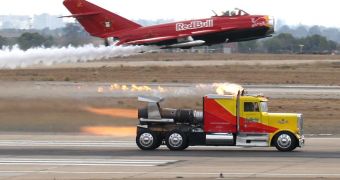Horse pulled vehicles dominated roads until the development of viable inner combustion engines, around 1900. The first self-propelled truck was presented in Paris in 1769. This vapor vehicle was designed for carrying heavy weaponry and traveled with 4 km (2.5 mi) per hour. But the slow speed turned it rather into a curiosity. During the 19th century, the speed of vapor vehicles increased. Battery- or gasoline-based models emerged too.
Trucks with advanced cabins, in which the drivers stay over the front wheels, have become popular in Europe since the '20s, while, in North America, the drivers often stay behind the front wheels and the engine. Power is generated by massive Diesel engines which ensure the traction force required for the movement of the loaded vehicle.
For each kilometer made, an articulated truck must push away 20 tonnes of air, that's why efforts have been made to turn them more aerodynamic. Aerodynamic shapes can save 25 % of the fuel, amortizing investments in 2 years. A cabin having the roof shaped like a wind threshold disperses the airflow over the square edges of the truck. This change eliminates many turbulences and air resistance, and the extra space of the cabin increases the comfort of the driver, who can stand up.
Skidding and folding can be tricky for articulated lorries (in which the truck and the trailer are connected through a rotative articulation). The anti-blocking brake systems allow preventing this issue while braking. As wheels exert the highest adherence to the road just before the brakes are applied, this system electronically detects the wheel movement, loosening the grip just before blocking the wheels. The brakes are applied and loosen the cycle very rapidly, until the truck stops. To share the load equally, most trucks have double wheels, except the front ones.
As said, today most trucks work on Diesel engines. Vapor trucks had to wait until starting, so that the water got heated. Battery trucks can be started immediately, but the batteries discharge quickly, thus their range is limited and their power is weak. Still, electric engines are used in vehicles for short distance tasks, like home delivery or in gulf cars. This type of functioning, implying continuous stops and starts, would wear out rapidly other types of engines.
These vehicles are also used for spaces where contamination would put lives at risk. Small electric trucks are used in railway stations for transporting baggages and goods. Electric buses are encouraged for cutting down contamination in some cities.
Trucks contaminate much more than cars. They make just 5 % of the traffic but generate as much phonic contamination as the rest of the traffic participants and inflict greater damage to roads and bridges. A loaded truck causes the road surface as much damage as 60,000 cars.
A truck transportation/railway transportation comparison shows that trucks are much more harmful for the environment and human life. For each billion tonnes of goods transported over 1 km (0.6 mi), a truck produces 0.22 kg (0.5 pounds) of carbon dioxide, 3.6 kg (8 pounds) of nitrogen protoxide, 0.81 kg (1.9 pounds) of hydrocarbons emissions, 0.27 kg (0.6 pounds) of colamine and kills or wounds 248 people, while for the same transportation, the railway produces 0.05 kg (0.1 pounds) of carbon dioxide, 0.22 kg (0.5 pounds) of nitrogen protoxide, 0.05 kg (0.1 pounds) of hydrocarbons emissions, 0.03 kg (0.12 pounds) of colamine and kills or wounds 10 people. Yet, railway transportation is more costly, and loading and unloading voluminous goods is slow, that's why trucks are still preferred.
Buses (almost) reached their modern shape in 1927: a rectangular box, with the driver in the front. Engines passed from the front of the bus below the floor. Style, comfort, speed (up to 130 km or 80 mi per hour) and security have improved. Despite the speed, stabilizers reduced the bouncing effect a lot. Anti-blocking brake systems, secured glass and headrest seats increased the security.
Trolleys capture energy from suspended cables. As they do not rely on a battery, they can work continuously, not being limited in their functioning by fix rails, like in the case of the trams, so that they can avoid obstacles or other vehicles. Trams and trolleys are re-introduced in some places to cut down the city pollution, but the electricity required for fueling them is produced by burning fossil fuels, a process that eliminates a lot of contaminating gases into the atmosphere.

 14 DAY TRIAL //
14 DAY TRIAL //